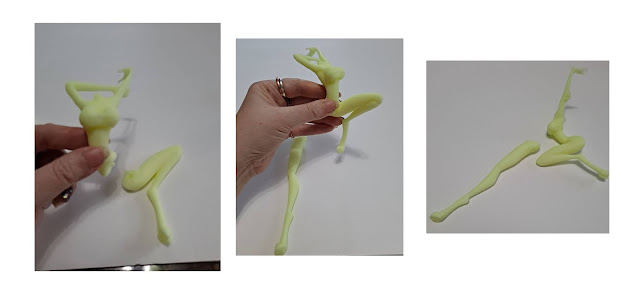A Guide To The Indigo Flourish Figurine Assembly
The point of this guide is primarily to help identify which pieces of the model go together.
We are taking these:
And building this: (the original drawing that inspired the sculpture)
The pieces included in the kit, as well as the super glue, the glue gun with sticks, and the clear base, should be all you need to complete the model. That said, there are a few tricks I used to complete it, such as using a glue gun to glue the tails on which I highly recommend you use for durability's sake, a cup and plate to hold pieces while drying, and paints to make the model more lifelike.
If you plan on painting your model, please visit the painting Indigo blog prior to assembly.
This assembly instruction blog is going to pretend you don't plan on painting the set. I did a white primer on this model to show the shaping better, after it was done.
The ending result will look like this:
So let's begin!
The best part about these pieces is how snug they fit when properly attached. I practiced attaching each piece prior to final gluing to fully understand how the figures are set. There's the top figure, Indi, and the bottom figure, Digo, who make up the Indigo twins. Digo's torso has a peg that attaches the hips while Indi's torso is smooth.
(The back of Digo, her torso has the shoulders closer together to support)
(Indi's torso has shoulders more spread apart for the upper arm gesture)
Indi's arm flourish looks like this:
Digo's arms are folded to support her weight look like this:
The legs: each character has a bent leg and a long leg. The long legs extend down and off of the base. Indi isn't going to stand on her own weight. We'll look at the connecting point later.
Indi's assembly:
Digo will be a little wobbly unless she's kneeling on the base.
Digo's assembly:

**If you plan on painting, this is the last chance.
Assembly below will limit the ability to paint effectively.**
Here's how to tell the head and hair pieces apart.
Indi: mouth open. Ponytail curves and swings to the right, like she's in motion.
Digo: mouth shut. Ponytail is curved up to down, she is at rest.
The hair pieces appear identical, but the notches inside the hairs are different. They line up with the notches on top of the heads. The hair pieces should be a tight fit, and to help glue the ponytails on, I used the glue cap as a stand to help them dry.
*The hair strands are fragile, but you can carefully click the heads into place without breaking the hair. I encourage a little glue placement before attaching the head to hair, so you only have to do it once.*

The next step is to glue the bodies to the heads. Remember, Indi's mouth is open. Digo's nose can rest on her arms if you choose, but generally, the head should stand on the neck freely. (The gray base in the pictures will be your clear base that was included)
I'm using a Jack Daniels glass to hold up Digo's tail for drying glue. Please note that the partially assembled model needs to be supported to balance even after the glue is dried. The two characters balance together once completed. For this model, I ended up gluing the base of the tail as well as the points where it touches her buttock, for extra weight support. I needed that glue gun to get the tails to attach reliably, since the pieces are solid and heavy.
The glue sticks insanely well to the plastic and holds up over numerous times I had to move them off the base. All of the pictures of the completed models involved glue gun, because I'm easily frustrated. Or smart. Not sure.
Indi's tail has a notch that is intended to stick to the underside of the top tail. After positioning Indi and her tail, you can hide glue in the notch and it works great.
In the drawing, Indi can hover and jump in excitement, but in real life, you might have to add a little glue on Indi's hip and rest on Digo's hip as well, or a little fur spike on the lower tail where it meets Indi's ankle. A little glue doesn't detract from the look of the finished model.
This is completely your preference, if you want the Indigos to be dependent on each other for balance, or would prefer Indi to float on her tail with some distance of Digo. When you thread the second tail through, there is an indentation for both tails to rest on each other, and you don't have to follow this, but I suggest you take the extra effort to line up both tails. Glue gun dries very fast so precision is key.
And that is the Indigo Flourish! Thank you for reading, and I hope that you found this guide useful.









































